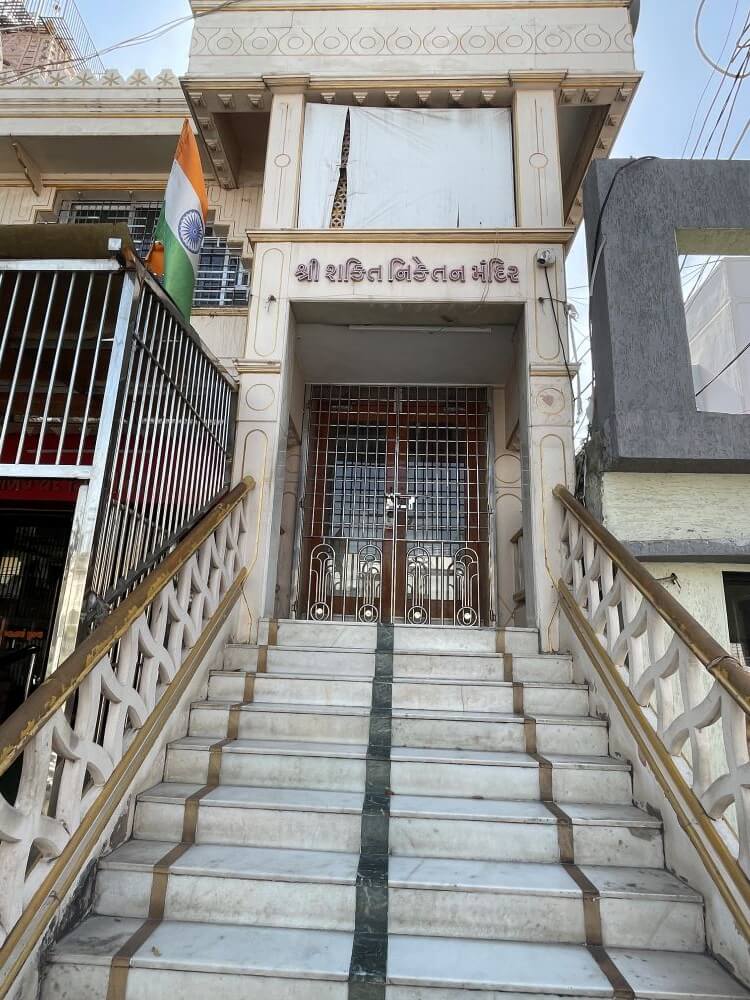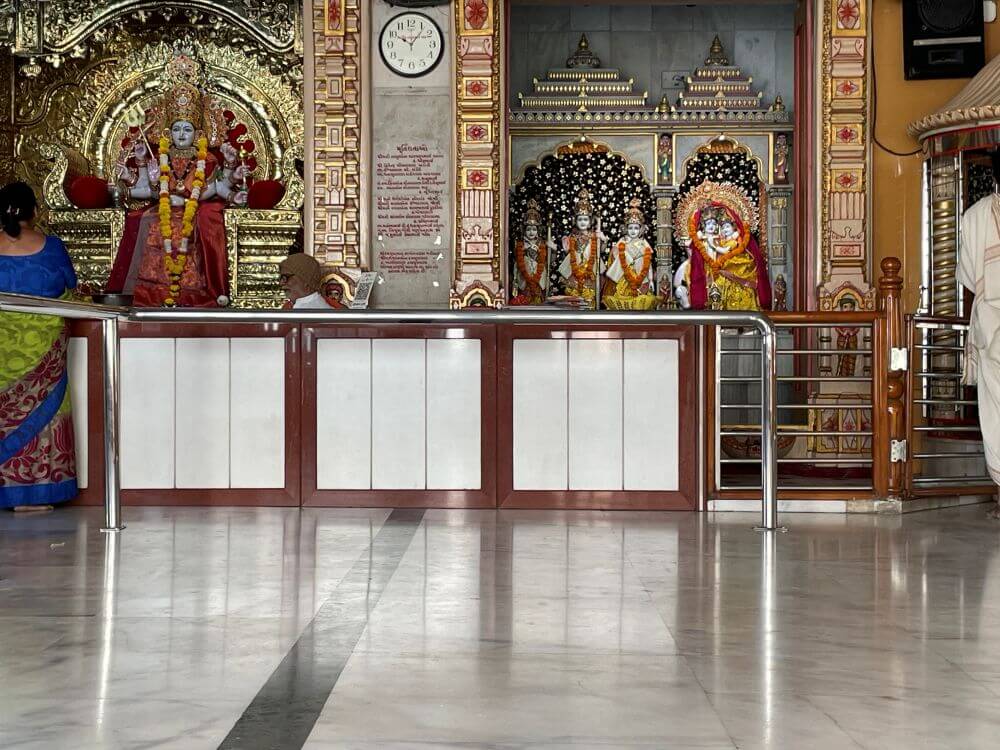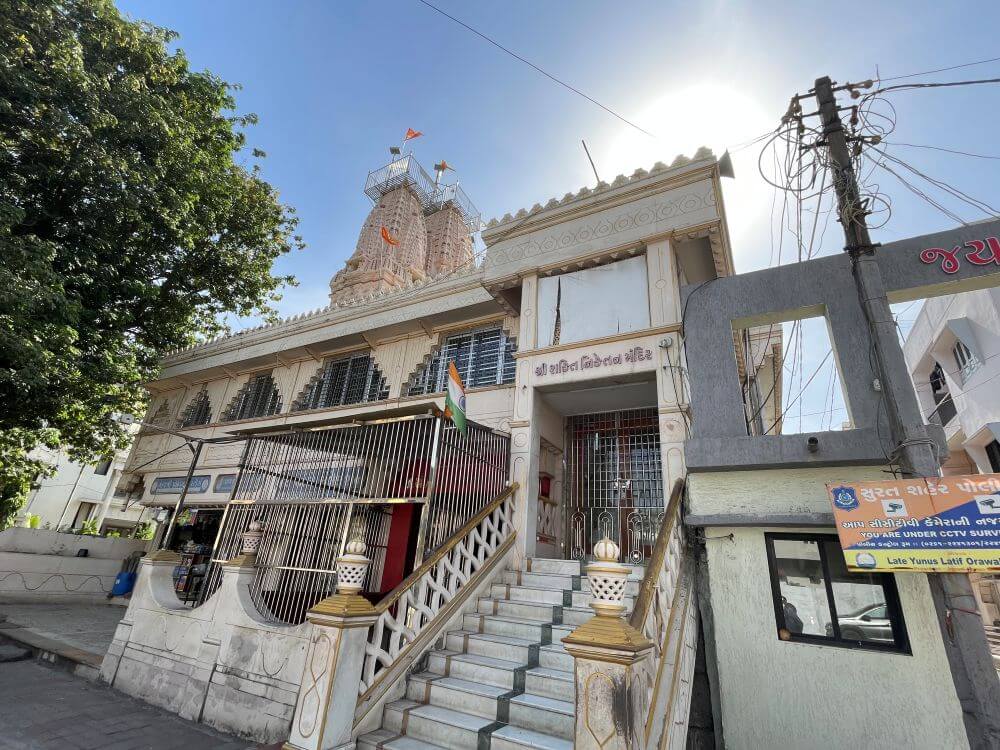 The maternal form of Adi Shakti Parvati is revered as Amba, Amba Bhavani, or Ambika. According to the Indian Cultural Lexicon, this same goddess manifests in three primary forms—Mahakali, Mahalakshmiand Mahasaraswati—each embodying different aspects of power and virtues. Amba Devi, as the embodiment of divine energy, has countless forms and names. The Shaktiniketan Temple, dedicated to this powerful deity, is located in the Adajan Patiya area of Surat. It is believed that this goddess fulfils all wishes, attracting a large number of devotees seeking her blessings.
The maternal form of Adi Shakti Parvati is revered as Amba, Amba Bhavani, or Ambika. According to the Indian Cultural Lexicon, this same goddess manifests in three primary forms—Mahakali, Mahalakshmiand Mahasaraswati—each embodying different aspects of power and virtues. Amba Devi, as the embodiment of divine energy, has countless forms and names. The Shaktiniketan Temple, dedicated to this powerful deity, is located in the Adajan Patiya area of Surat. It is believed that this goddess fulfils all wishes, attracting a large number of devotees seeking her blessings.
The Sri Durga Saptashati (a revered scripture) narrates the story of Ambika’s divine origins. According to this text, she is the Adi Maya (primordial goddess) and the supreme mistress of infinite power. The goddess has taken numerous incarnations to protect her devotees. In her first incarnation as Mahakali, she destroyed the demons Madhu and Kaitabha. In her second incarnation as Mahalakshmi, she vanquished Mahishasura, the buffalo demon. In her third incarnation as Mahasaraswati, she slew the demons Shumbha and Nishumbha. The Durga Saptashati specifically refers to Mahishasuramardini (the slayer of Mahishasura) as Ambika in her second form, highlighting her role as a powerful protector and saviour of the world.
The mythological story behind this incarnation of the goddess describes how the demon Mahishasura defeated the gods and claimed Indra’s throne. In their despair, the gods, led by Prajapati Brahma, approached Lord Shiva and Lord Vishnu for help. Hearing of the calamity, Vishnu was enragedand a great radiance emanated from his mouth. Similarly, a divine light emerged from the bodies of all the gods, combining to form a magnificent female form. This goddess was armed with weapons gifted by the gods: Lord Shiva gave her a trident (trishul), Lord Vishnu presented her with his discus (chakra)and other deities contributed their weapons to empower her. This goddess, with thousands of arms, first defeated the demon commanders—Chikshura, Chamara, Udgara, Asiloma, Bashkala, Parivarita, Bidalaand others—and ultimately vanquished Mahishasura himself. This goddess is worshipped under various names, including Durga, Bhagwati, Chandika, Ambaand Ambika.
the gods, led by Prajapati Brahma, approached Lord Shiva and Lord Vishnu for help. Hearing of the calamity, Vishnu was enragedand a great radiance emanated from his mouth. Similarly, a divine light emerged from the bodies of all the gods, combining to form a magnificent female form. This goddess was armed with weapons gifted by the gods: Lord Shiva gave her a trident (trishul), Lord Vishnu presented her with his discus (chakra)and other deities contributed their weapons to empower her. This goddess, with thousands of arms, first defeated the demon commanders—Chikshura, Chamara, Udgara, Asiloma, Bashkala, Parivarita, Bidalaand others—and ultimately vanquished Mahishasura himself. This goddess is worshipped under various names, including Durga, Bhagwati, Chandika, Ambaand Ambika.
The Shaktiniketan Temple houses the idol of Amba Devi and is uniquely located on the second floor of a building. The ground floor features various shops, while the temple on the upper floor can be reached by climbing an 18-step staircase. The temple consists of a spacious and semi-open sabhamandap (assembly hall) and a garbhagriha (sanctum). Inside, a steel-pipe framework is installed to manage the queue of devotees. A prominent feature of the hall is a large statue of a lion seated on its hind legs, placed on an elevated platform. To the right of the hall is the office of the temple trustees.
The temple has three sanctums—one main and two subsidiary. The main sanctum houses a beautifully crafted marble idol of Amba Devi, seated on an intricately designed golden throne. The idol is depicted with eight arms (Ashtabhuja) and adorned in a radiant white hue. She holds a trident (trishul), discus (chakra), mace (gada)and sword (khadga) in her hands. In her other hands, she carries a lotus (padma), a conch (shankha) and a scripture (pothi). Her one hand is shown in the gesture of granting protection (abhaya mudra). Above the sanctum, a large relief sculpture of Gajalakshmi (Lakshmi flanked by elephants) is prominently displayed. The left subsidiary sanctum houses a Shiva lingam (symbolic representation of Lord Shiva). The right subsidiary sanctum features idols of Lord Rama, Lakshmanaand Sita alongside Radha and Krishna. These idols are placed within a grand shrine built atop a crescent-shaped vajrpeeth (a sacred platform). Additionally, on either side of the main sanctum, there are smaller shrines dedicated to Lord Ganesha and Lord Hanuman, completing the temple’s spiritual ambiance.
These idols are placed within a grand shrine built atop a crescent-shaped vajrpeeth (a sacred platform). Additionally, on either side of the main sanctum, there are smaller shrines dedicated to Lord Ganesha and Lord Hanuman, completing the temple’s spiritual ambiance.
The temple features three spires (shikhara), designed in the Nagara style of architecture. These spires follow the Urushringa pattern, where smaller replicas of the main spire are placed on its “shoulders.” At the four corners of the spires, there are intricately crafted clusters of pots, symbolising the maternal aspect of the goddess. The sabhamandap (assembly hall) also has a smaller, pyramid-shaped spire atop it.
Daily rituals such as aarti (worship with light) and abhishek (ritual bathing of the deity) are performed at the temple. Fridays witness a significant number of devotees seeking the goddess’s blessings. The temple celebrates the Navratri festival with grandeur and fervour. Other festivals like Rama’s birth (Ram Navami), Krishna’s birth (Janmashtami), Hanuman Jayantiand Ganesh Jayanti also attract large crowds of devotees.
